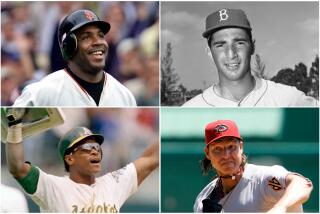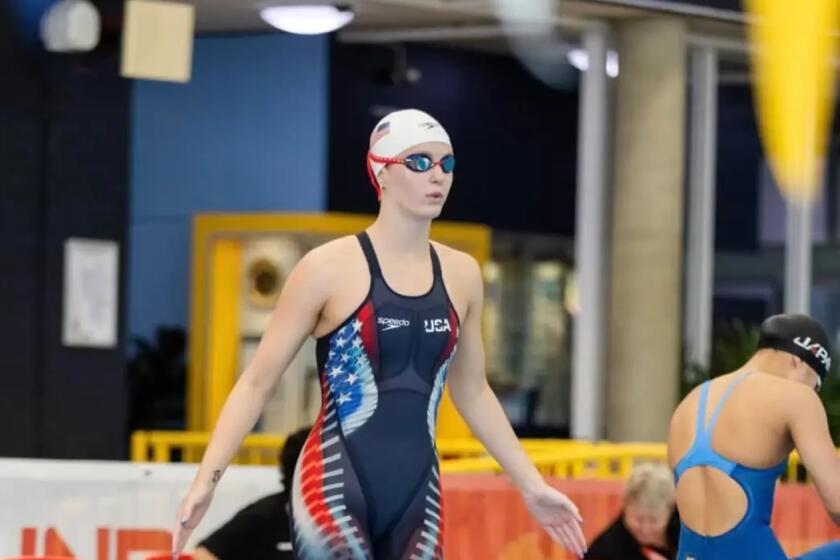Old-Timer Sports Leagues: Some Hits, Some Strikeouts : Marketing: Events where older athletes retain their skills--such as golf--become big business. Those where skills are harder to maintain--such as baseball--have flopped.
- Share via
Billy Cunningham, formerly of the Philadelphia 76ers, turned to fellow announcer Bill Russell, the ex-Boston Celtics great, as they watched another pair of National Basketball Assn. pensioners laboring in a one-on-one contest at the Trump Taj Mahal casino in New Jersey.
Connie Hawkins, 49, was leaning against Rick Barry, 48, sweating, breathing heavily, gathering himself for another push to the basket. When he started his move, Hawkins looked like he was running in knee-deep snow.
“Fatigue,” Cunningham intoned, “is becoming a factor.”
At that point, the game was all of two minutes old.
Sports heroes don’t always age gracefully, but the kind of money available for them to display their skills, however diminished, keeps pulling them back into the arena for another hurrah.
Nostalgic interest in the stars of yesteryear has spawned a whole new industry. But just stocking a court or ball field with a few immortals doesn’t guarantee success. Numerous entrepreneurs have struck out swinging for a senior sports home run.
The talent pool of aging pro athletes contains such statistical outliers as baseball’s Nolan Ryan and heavyweight boxers Larry Holmes and George Foreman, who continue, well past age 40, to tangle with their juniors in regular professional competition.
But for much of the seemingly over-the-hill gang, the only playgrounds left are the “legends” or “masters” events held in dozens of sports, from baseball to rodeo, where prize money ranges from cab fare to hundreds of thousands of dollars and contests are tailored to make allowances for age and ebbing prowess.
Everybody’s model for the brass ring of geriatric sports is the Senior PGA Tour, which last year had about 40 events with total purses of nearly $25 million. More than half its events are televised, either on the ESPN cable sports network or on broadcast networks, giving the tour tremendous exposure and helping it to annual revenues exceeding $40 million.
The Senior Tour has revived the careers of fading stars such as Chi Chi Rodriquez, turning them into promotional dynamos as well as consistent prize winners. Mike Hill, the top moneymaker on the 1991 Senior Tour with winnings of $1,065,657, earned more than the regular PGA Tour’s money leader, Corey Pavin, who cashed checks worth $979,430.
The success of the Senior Tour has emboldened others to try to duplicate it without necessarily analyzing what it is about senior golf that makes it uniquely appealing, as opposed to, say, senior baseball.
The difference is this: A 60-year-old professional golfer typically comes a lot closer to perfection hitting a five iron than a 42-year-old ex-major leaguer does trying to leg out a double.
“There’s very few things that there’s anything artistic about watching a guy who’s past his prime do,” said Don Ohlmeyer, the Los Angeles-based TV sports producer who created golf’s Skins Game and Senior Skins Game, both hugely successful on network TV.
Failure to grasp that principle cost investors in the now-defunct Senior Professional Baseball Assn. a lot of money.
The SPBA was an eight-team collection of former big-leaguers that played at spring training sites in Florida for two brief seasons before collapsing last year. In its first season, when the league had novelty going for it, average attendance was 921.
New York adman Jim Russek owned the SPBA’s Winter Haven, Fla., franchise, such as it was. He thinks that the league fell flat partly because Floridians were too cheap to come to the games when they could see many on cable television on a delayed basis.
“It’s a state where people queue up for dinner at 4:30 because it’s half-price,” Russek griped.
But Bill Lee, 45, former pitcher for the Boston Red Sox and Montreal Expos and a member of Russek’s Winter Haven Super Sox, had a different analysis. He thought the games were overpriced at $8 a ticket, and some of the big names were out of shape, making their efforts less than magical.
Quality control can be a formidable challenge in senior sports.
The pay-per-view TV “Clash of the Legends” in February between basketball’s Julius (Dr. J) Erving, 42, and Kareem Abdul Jabbar, 45, was promoted with ads that invoked Erving’s trademark leaping slam-dunk.
Trying to assess the potential appeal of the one-on-one contest, Steve Grubbs, senior vice president of the BBDO Worldwide advertising firm in New York, offered: “Dr. J and Kareem are heroes. There’s a certain satisfaction in seeing that these guys can still compete.”
At least one can, anyway. Jabbar crushed Erving, 41-23, in a brief yet boring mismatch in which Erving’s jumping ability was nowhere in evidence. (The Rick Barry-Connie Hawkins game was a preliminary event.)
Erving’s production company declined to release ratings, but one industry newsletter estimated the pay-per-view audience at around 80,000 homes. At $19.95 a ticket, the show would have grossed nearly $1.6 million.
In order to create more balanced competition--and to reduce injuries--many senior events make straightforward concessions to age:
* On the Senior Pro Rodeo Tour, officials ask their livestock contractors to provide lighter animals for the 60-plus age group in the calf-roping event.
* The pro skiing Tournament of Champions staggers starts so that a relative youngster such as Franz Klammer, 36, won’t have too great an advantage over such veterans as Stein Ericksen, 63.
* The way that varnish is applied to the lanes on the Professional Bowlers Assn.’s Senior Tour makes them “play” easier than the lanes that confront bowlers on the regular tour. Tricky oiling patterns can push average scores down by 20 or 30 pins a game.
For some fans of senior sports, however, the performances themselves are beside the point. The real thrill is hanging around with the athletes and drinking in their aura.
Much of what a corporation buys when it sponsors a golf tournament is a way to impress clients and show employees a good time by letting them rub shoulders with the sport’s giants at tournament cocktail parties or in a pro-am round of golf.
Jack Mahoney, sports marketing consultant for John Hancock Life Insurance Co. in Boston, said a key difference between pro golf’s two age divisions is that “the senior pros have gone overboard to be hospitable.”
The older players are generally much better schmoozers--and they come cheaper too.
Rod Laver, whom many consider the greatest tennis player in history, thinks that’s a good selling point for senior tennis. The Assn. of Tennis Professionals, which runs the regular pro tour, is trying to get an ATP Senior Tour off the ground with Laver as one of its stars.
Part of the idea is that business people who gravitate toward tennis can more easily identify with a Laver than an Andre Agassi.
“You’re not going to find many 22-year-olds who are chairmen of companies,” Laver, 53, said in a recent conversation from his home in Rancho Mirage. “Most of them are in the 40s to 60s and grew up when we were in our prime.”
Still, the mass appeal of seniors tennis as a spectator sport is a more doubtful proposition. The kickoff tournament for this year’s Senior Tour was sandwiched between major women’s and men’s tournaments in March at the Hyatt Grand Champions resort in Indian Wells.
That helped the seniors get more attention than a stand-alone event would have attracted, and it eased the pressure for the event to support itself with its own sponsorship.
Laver feels that in order to grow, the Senior Tour will need to be nurtured that way by the regular ATP Tour.
From his perspective, it makes sense for both groups. The younger players clearly provide the highest level of competition, but the John Newcombes and Stan Smiths can better supply the feel-good atmosphere that sponsors crave.
Meanwhile, on the baseball diamond, some survivors of the Senior Professional Baseball Assn. are tinkering with a new formula. They’ve reconfigured as the New England Grey Sox. The group of mainly ex-Red Sox players will barnstorm the Northeast this summer, challenging local teams.
With them will be Lee, a left hander nicknamed “Spaceman” for his eccentric opinions, among them that the American League’s designated hitter rule is responsible for the destruction of the earth’s ozone layer.
Although Lee thinks the barnstorming approach should click with New England fans, he acknowledged that senior golfers will always have an aesthetic advantage over their baseball cousins.
“When Billy Casper tops his ball off the tee,” Lee explained, “he doesn’t have to run it out.”
More to Read
Go beyond the scoreboard
Get the latest on L.A.'s teams in the daily Sports Report newsletter.
You may occasionally receive promotional content from the Los Angeles Times.










